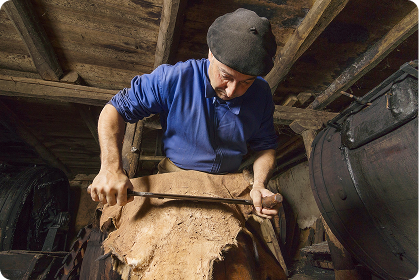
Types, Process & Care Decisions
Leather Tanning Basics for Restorers: Processes, Types, and How It Impacts Repair
Learn how modern tanning works, the differences between mineral, vegetable, oil and combination tanning, and why this matters when choosing professional restoration products from LeTech USA.
Tanning is the stage that turns raw hide into stable, durable leather. For restorers and detailers, understanding tanning helps you diagnose surfaces correctly, select the right cleaners, pigments and topcoats, and set client expectations about feel, breathability and wear.

Key terms (quick glossary)
- Grain/meré — the natural surface pattern retained on aniline and quality hides.
- Split — lower layer of the hide after splitting; used for suede or coated leathers.
- Crust — tanned leather before finishing/dyeing.
- Corrected grain — grain lightly sanded and finished to hide defects; usually more sealed.
How natural leather is tanned (process overview)
Industrial tanning is typically split into three phases: preparation (soaking, liming, deliming, bating), tanning (stabilizing collagen with mineral/vegetable agents), and post-tanning/finishing (fatliquoring, drying, conditioning and topcoats). Temperature, pH and time control are critical to avoid damage and uneven results.

Main tanning types & how they behave in restoration
1) Mineral (Chromium/Aluminum/Zirconium)
Most modern upholstery leather is chrome tanned (often visible as wet-blue in production). It’s elastic, breathable and strong. Aluminum/zirconium systems are used for specific properties or in combinations.
- Restoration behavior: usually less absorbent than aniline veg-tan; responds well to water-based cleaners, pigment systems and durable topcoats. Heat and solvent aggression can gloss or harden finishes.
2) Vegetable tanning
Uses natural tannins (oak, chestnut, mimosa, etc.). Common in premium goods, belts, saddlery and small leather goods. It has a characteristic matte glow, warm tone and patina potential.
- Restoration behavior: more absorbent; prone to water marks and darkening. Prefer gentle, pH-balanced cleaning, oil/wax replenishment and breathable protection. Pigment coverage should be conservative to preserve character.
3) Oil (fat) tanning & chamois
Historic process producing soft, absorbent leather (e.g., chamois). Today it appears in niche goods.
- Restoration behavior: highly absorbent; avoid strong aqueous or solvent cleaners. Use mild detergency and targeted re-fatliquoring where appropriate.
4) Synthetic systems (sintans) & combinations
Modern leathers are often combination tanned (e.g., chrome + veg) to balance hand, strength and cost. Combinations are popular in footwear, bags and furniture.
- Restoration behavior: properties vary. Always test: absorbency, colorfastness and finish integrity before choosing cleaner, recolor system and topcoat.
Finishing & why topcoats change cleaning rules
After tanning, leather may be dyed, embossed and sealed. Finishes range from open-pore aniline to semi-aniline (light protective coat) to pigmented/protected with stronger seals. High-gloss, plastic-like shine may indicate bicast (PU film over split), which behaves more like a coated surface.
Practical takeaways for pros
- Identify first. Check nap, scratch mark, water absorbency and sheen to estimate finish class.
- Match chemistry to structure. Use pH-balanced, residue-free cleaners for anilines; robust cleaners and pigments for sealed/protected leathers.
- Seal your work. Finish with appropriate topcoat (matte/satin/gloss) for durability and hand feel.
LeTech USA is part of LeTech International (UK), with R&D and manufacturing in Northampton — the leather capital of Britain. Trusted by workshops, detailers and enthusiasts worldwide.
Share

























